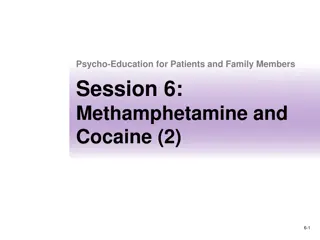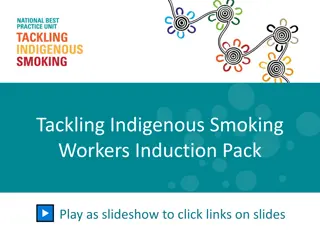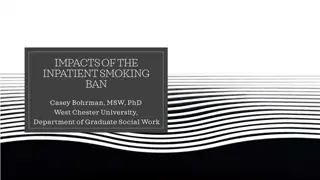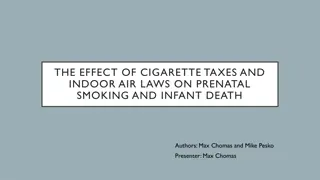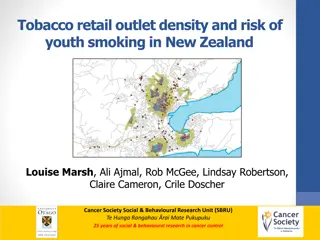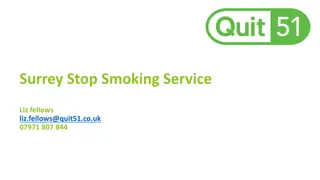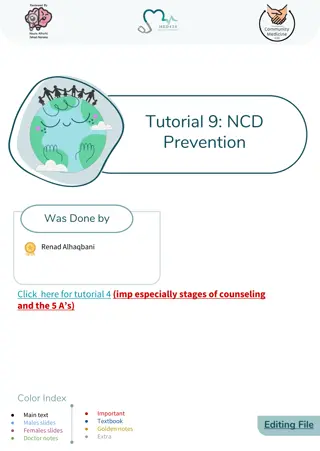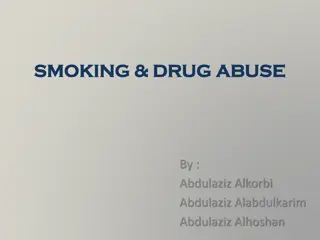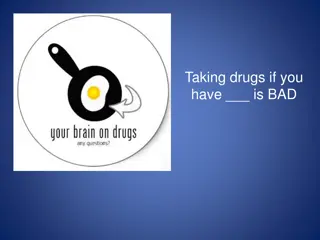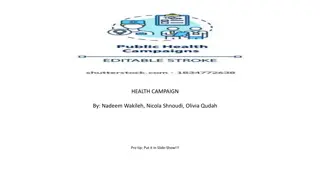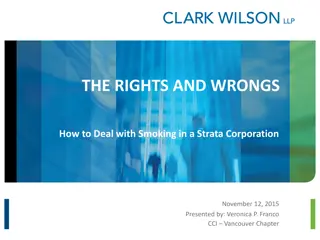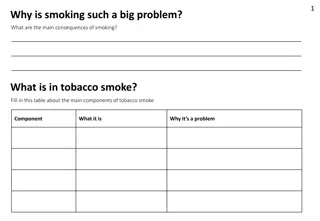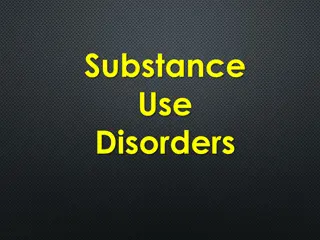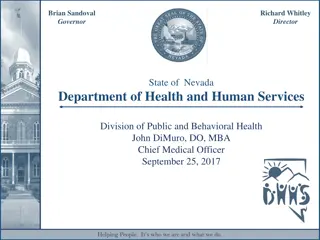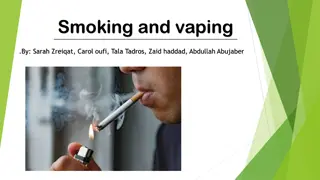Understanding the Effects of Smoking and Substance Abuse
Explore the dangers of smoking and substance abuse through discussions on epidemiology, health risks, effects on pregnancy and children, smoking cessation strategies, and factors leading to substance abuse. Engage with multiple-choice questions to test your knowledge on the topic.
Download Presentation

Please find below an Image/Link to download the presentation.
The content on the website is provided AS IS for your information and personal use only. It may not be sold, licensed, or shared on other websites without obtaining consent from the author. Download presentation by click this link. If you encounter any issues during the download, it is possible that the publisher has removed the file from their server.
E N D
Presentation Transcript
Smoking And Substance Abuse Done by: - Ghaida Al-Masaad - Malak Al-Khathlan - Reema Hazazi - Najla Bin Rabah
Objectives: 1- Epidemiology of smoking in Saudi Arabia 2- Risks of smoking (Morbidity and Mortality) 3- Effect of passive smoking on pregnancy, children, . 4- Helping the smoker to quit with smoking cessation aids and overcoming nicotine withdrawal symptoms 5- Role of PHC physician smoking cessation clinic 6- Update of the smoking cessation medication in pharmacological management 7- Nicotine preparations, Varenicline, Bupropion, . 8- Factors that lead to substance abuse 9- Highlighting types of substance abuse 10- Method to approach subjects with substance abuse
MCQs 1- What is the expected annual death due to tobacco use in 2030: A. 500.000 B. 400.000 C. 6.000.000 D. 8.000.000
MCQs 2- Effect of second-hand smoking on children: A. Asthma B. Otitis media C. All of the above D. None of the above
MCQs 3- When it is contraindicated to use Bupropion? A. Heart disease B. Seizure C. Kidney stones D. Peptic ulcer
MCQs 4- Which one of the following is the most common substance abuse: A. Cocaine B. Alcohol C. Cannabis D. Steroids
MCQs 5- Which one of the following cases is at risk of substance abuse: A. People who are mentally well. B. Young people whose there families use certain medications. C. People who are just graduated. D. Children who goes to school and blend with others in society.
FACT: SMOKING IS THE ONLY LEGAL CONSUMER PRODUCT THAT KILLS YOU WHEN YOU USE IT
What makes the smoking dangers? Tobacco
Epidemiology -Tobacco is the single greatest risk factor for cancer mortality worldwide causing estimated 22% death per year. -21% of the global population aged 15 and above smoked tobacco. -Each day, more than 3,200 people younger than 18 years of age smoke their first cigarette.
Epidemiology of smoking in Saudi Arabia A study was conducted between April and June 2013 to assess the status of tobacco consumption in the Kingdom of Saudi Arabia (KSA). - Overall prevalence of current smoking was 12.2 % and males were more likely to smoke than females (21.5 % vs. 1.1 %). - Mean age of smoking initiation was 19.1 years ( 6.5 years) with 8.9 % of smokers starting before the age of 15 years. -
Epidemiology of smoking in Saudi Arabia -A study reveals that the most common trigger for Saudi female to start smoking is their experience of seeing someone they know is smoking
Role Play with Video
Why teens and kids start smoking?
Why teens and kids start smoking? Peer influence Adult smoking Coping with stress Advertising Media
Risks of smoking (Morbidity and Mortality)
Short term health consequences: Respiratory and non respiratory: Addiction to nicotine
Long-term health consequences The fact that most young people who smoke regularly continue to smoke throughout adulthood. Cigarette smokers have a lower level of lung function than those persons who have never smoked Smoking reduces the rate of lung growth.
Cancer Chronic lung diseases Cardiovascular Strokes
In adults, cigarette smoking causes heart disease and stroke. Studies have shown that early signs of these diseases can be found in adolescents who smoke. The resting heart rates of young adult smokers are two to three beats per minute faster than nonsmokers.(1)
Smoking hurts young people's physical fitness in terms of both performance and endurance even among young people trained in competitive running. On average, someone who smokes a pack or more of cigarettes each day lives 7 years less than someone who never smoked. Teenage smokers suffer from shortness of breath almost three times as often as teens who don't smoke, and produce phlegm more than twice as often as teens who don't smoke.(3) Teenage smokers are more likely to have seen a doctor or other health professionals for an emotional or psychological complaint.(3)
Teens who smoke are three times more likely than nonsmokers to use alcohol, eight times more likely to use marijuana, and 22 times more likely to use cocaine. Smoking is associated with a host of other risky behaviors, such as fighting and engaging in unprotected sex.
CANCER Nearly 9 out of 10 lung cancers are caused by smoking cigarettes. Treatments are getting better. In the United States, more than 7,300 nonsmokers die each year from lung cancer caused by secondhand smoke. Smokers have a greater risk for lung cancer today than they did in 1964, even though they smoke fewer cigarettes? WHY?!
About 13,150 new cases of laryngeal cancer (10,490 in men and 2,660 in women) About 3,710 people (2,970 men and 740 women) will die from laryngeal cancer
Effect of passive smoking on pregnancy
A study found a significant association between SHS exposure during pregnancy and decreased birth weight. Second-hand smoke are a miscarriage, low birth weight, early birth, learning or behavioral deficiencies in your child, and Sudden Infant Death Syndrome. Smoking during pregnancy in many countries is recognized as the most important preventable risk factor for an unsuccessful pregnancy outcome 2003 study.
Effect of passive smoking on children:
Helping the smoker to quit: - Have a Plan - Stay on Track
Have a Plan: 1. Cold turkey. 2. Behavioral therapy. 3. Nicotine replacement therapy. 4. Medication. 5. Combo treatments.
Stay on Track: 1. Know your triggers and avoid them early on. 2. Know that the first few days are the toughest. 3. Try a new hobby with friends who don't smoke. 4. Reward yourself. 5. Don't give in to your cravings.
Role of PHC physician smoking cessation clinic: - GPs should take the opportunity to advise all patients who smoke to quit when they attend a consultation. Five A s Five R s Ask Relevance Advice Risks Assess Rewards Roadblock s Assist Repeat Arrange
Overcoming nicotine withdrawal symptoms:
Different pharmacological tools: Before choosing a pharmacologic tool, physician should consider Advantages of each, Disadvantages, Contraindications
Pharmacological management: Nicotine replacement therapy(NRT). Non- NRT: Bupropion- Varniciline
Pharmacological management: NRT, varenicline or bupropion should normally be prescribed as part of an abstinent- contingent treatment, in which the smoker makes a commitment to stop smoking on or before a particular date (target stop date). The prescription of NRT, varenicline or bupropion should be sufcient to last only until 2 weeks after the target stop date. Subsequent prescriptions should be given only to people who have demonstrated, on reassessment, that their quit attempt is continuing.
Nicotine replacement therapy: NRT works by replacing nicotine from cigarettes and relieving or preventing nicotine withdrawal symptoms. It is available as: patches , short acting oral forms (lozenges, chewing gum) ,nasal sprays, nicotine inhalator. Contraindicated in post MI patients ,patients with serious arrhythmias and pregnant and lactating women.
Nicotine replacement therapy: Nicotine patch: Nicotine patches are the preferred method of NRT because of the ease of use and high concentrations of nicotine delivered. Nicotine levels rise gradually and then plateau for most of the day. Advantages: Ease of use, minimal side effects and demonstrated efficacy. Adverse effects: Can lead to localized skin sensitivity and irritation
Nicotine replacement therapy: Nicotine gum: It cause a gradual rising and falling of nicotine levels throughout the day. Used in place of smoking when the patient craves nicotine. Appropriate patient education is required for optimal use of the nicotine gum chewing and parking . Adverse effects: Sore mouth, throat or jaw, hiccups, dyspepsia, nausea, flatulence and gastrointestinal discomfort.
Nicotine replacement therapy: Nicotine nasal spray: It is used in place of smoking when the patient craves nicotine. Plasma nicotine levels peak within 10 minutes and are about two-thirds those of cigarette (fast absorption). Its available for prescription use only. Adverse effects: Headache, burning, rhinitis, watering eyes, nasal or throat irritation, sneezing and coughing.





